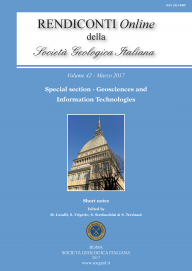
Dal modello concettuale al modello numerico: il caso di studio del sistema acquifero di Follonica (GR, Toscana meridionale)
Giulio Masetti (a), Simone Da Prato (a), Matia Menichini (a), Brunella Raco (a), Guido Lavorini (b),
Pio Positano (b) & Annalena Puglisi (b)
(a) CNR - Istituto di Geoscienze e Georisorse - Via G. Moruzzi, 1, 56124, Pisa, Italy. Corresponding author e-mail: masetti@igg.cnr.it.
(b) Regione Toscana - Sistema Informativo Territoriale e Ambientale - Via di Novoli, 26, 50127, Firenze, Italy
Volume: 42/2017
Pages: 54-58
Abstract
The groundwater body hosted in the Follonica coastal plain (Grosseto, Italy) is the Italian aquifer system that was chosen for the experimentation of the FREEWAT Platform, a collection of free and
open source software tools for water resource management and quantitative and qualitative modeling developed within the EU project Horizon 2020. In consideration of the studies carried out by the Institute of Geosciences and Earth Resources of the Italian National Research Council from 2006 to 2015 for the geological, hydrogeological and geochemical characterization of the 66 regional groundwater bodies (CIS), the Tuscany Region, partner of the project, has entrusted CNRIGG for the implementation of the numerical model.
A conceptual model of the aquifer system was developed by processing and combining all the geological, hydrogeological and geochemical-isotopic data. The supposed hydrostructure was tested and validated through its 3D "solid" construction, defining the geometry and the physical limits of the multi-layered aquifer system and ensuring its coherence and consistency with respect to the other geographical databases. Hydrogeological and geochemical data processing led
to identify the aquifer system feeding components, the relationships between surface hydrography and groundwater and the main physical and chemical processes taking place (ion exchange, seawater ingress, etc). On this basis, the development and implementation of the flow model has started, based on the Modflow code.
A focus group was organized as part of the project and stakeholders were involved with their active participation to the elaboration of the conceptual model by sharing data and other useful information.
This paper describes the methodology used and the results obtained so far.
Keywords
Toscana meridionale, corpi idrici sotterranei, modello concettuale, modello idrostrutturale, modello numerico di flusso, open source.
Get Full Text